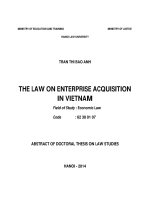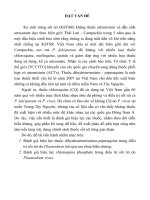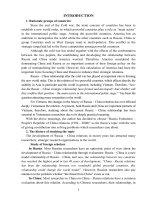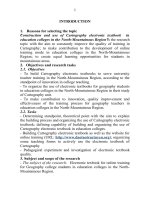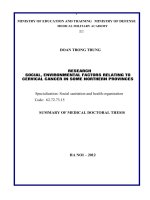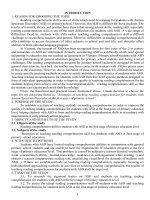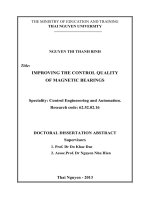Tóm tắt luận án tiếng anh digital transformation of coffee supply chain to boost exports in the central highlands provinces
Bạn đang xem bản rút gọn của tài liệu. Xem và tải ngay bản đầy đủ của tài liệu tại đây (2.88 MB, 27 trang )
MINISTRY OF EDUCATION AND TRAINING
FOREIGN TRADE UNIVERSITY
DOCTORAL
DISSERTATION SUMMARY
DIGITAL TRANSFORMATION OF COFFEE
SUPPLY CHAIN TO BOOST EXPORTS IN THE
CENTRAL HIGHLANDS PROVINCES
Major: International Economics
Code: 9310106
TRAN LUC THANH
Ha Noi, 2023
The dissertation
University (FTU)
is
completed
at:
Foreign
Trade
Academic supervisors:
1. Assoc. Prof. Dr. Tran Quoc Trung
2. Assoc. Prof. Dr. Nguyen Xuan Minh
Reviewer 1:
Reviewer 2
Reviewer 3
The dissertation will be defensed before the University
Committee at Foreign Trade University
Athour
day
month
year
The dissertation can be accessed at:
- The National Library
- The Library of Foreign Trade University
LIST OF PUBLICATIONS
1. Tran Luc Thanh & Nguyen Xuan Minh (2022),
Factors affecting the Digital transformation of export
coffee supply chains in the Central Highlands provinces,
Proceedings: The 10” International Conference on
Emerging Challenges: Strategic Adaptation in the World
of Uncertainties, Thanh Nien Publishing House, ISBN:
9786043872064.
2. Tran Luc Thanh & Nguyen Xuan Minh (2022), The
Current situation of coffee export supply chains in the
Central Highlands provinces, Proceedings: International
Conference for Graduate Education: Business and
Economics issues for building a more sustainable and
socially responsible economy, Lao Dong Publishing
House, ISBN: 9786043862164.
3. Tran Luc Thanh & Tu Thuy Anh (2022), Applying
digital transformation of export coffee supply chains of
enterprises in the Central Highlands provinces, Journal
of International
Economics
2615-9848, No 151, page 37-54
and
Management,
ISSN
4. Tran Luc Thanh (2021), Digital Transformation in the
Coffee
Supply
Chain of the Central Highlands,
Proceedings: Enhancing Adaptive Capacity of the
Economy and Enterprises in the Context of the Covid-19
Pandemic, Foreign Trade University, July 2021.
INTRODUCTION
1. Rationale
The robust development of Digital Transformation and the
Fourth Industrial Revolution is fundamentally altering the entire
landscape of production methods, the way humans create material
wealth, exchange goods, and consume resources. In this context,
the global agriculture sector is also undergoing significant
influence and a strong transformation, giving rise to an entirely
new approach to agricultural production known as digital
agriculture or Agriculture 4.0. A collection of tangible and
intangible tools and resources is fostering a breakthrough
development in agricultural production sectors and agricultural
supply chains, collectively termed digital technology. This
encompasses the Internet of Things (IoT), Artificial Intelligence
(AI), Cyber-Physical Systems (CPS), Big Data, Blockchain, and
Cloud Storage. Digital transformation (DT) is not a novel concept
within the coffee industry. Vietnam stands as the world's secondlargest coffee exporter by volume; however, the value derived
from Vietnamese coffee products (value added) for Vietnamese
enterprises remains relatively low. To empower the coffee
industry to grasp and keep pace with the technological
advancements in coffee production, processing, and consumption
on a global scale, and to effectively meet the consumption needs
of markets
such as Europe,
America, Japan, and the EU,
swift
implementation of DT within the coffee export supply chain is
imperative. Based on the guidelines provided by the Ministry of
Planning and Investment and USAID
regarding DT
for
Vietnamese
businesses, this study aims to explore
the
fundamental factors of DT in the coffee supply chain and analyze
the interaction among these factors. It seeks to establish a
theoretical model and validate it using real-world data collected
2
from the market. The study aims to provide scientifically
objective conclusions, which hold significance not only for the
coffee industry but also for other agricultural products
2. Research objectives and Research questions
2.1. Research objectives
- Overall research objective: Research on digital transformation
of the coffee supply chain for export promotion in the Central
Highlands provinces.
- Specific research objectives: (i) Constructing a research model
on the digital transformation of the export coffee supply chain,
(ii) Analyzing the influences of digital transformation enablers in
the coffee supply chain (IoT, AI, big data, applications) on the
digital transformation process (DTP), the effects of the DTP on
involved parties (suppliers, intermediaries, and customers) within
the coffee export supply chain, and the current state of the coffee
export supply chain in the Central Highlands provinces, (iii)
Propose solutions to promote digital transformation within the
coffee export supply chain in the Central Highlands provinces.
2.2. Research questions
(i) Which factors influence the DT of the coffee export supply
chain in the Central Highlands provinces? (ii) How does the
impact of the coffee export supply chain's DTP affect the
involved parties (suppliers, intermediaries, and customers) within
the coffee export supply chain of the Central Highlands
provinces?? (iii) What is the current state of DT in the coffee
export supply chain in the Central Highlands Provinces? (iv)
What solutions can be suggested in order to promote the DTP of
the coffee export supply chain to enhance coffee exports in the
Central Highlands provinces?
3
3. Object and Scope of research
3.1. Object of research: Digital Transformation of the coffee
export supply chain in the Central Highlands Provinces;
Specifically, the impact of supply chain digitalization platforms
(loT, AI, Big Data, Applications) on the DTP and the
implications
of
DTP
for
the
Participants
(Suppliers,
Intermediaries, and Customers) in the coffee export supply chain
across the 5 Central Highlands Provinces.
3.2. Scope of research
In terms of spatial scope: A study on coffee supply chain
activities in the five Central Highlands provinces, namely Dak
Lak,
Gia
Lai,
Kon
Tum,
Lam
Dong,
and
Dak
Nong,
and
businesses engaged in coffee production and export activities
from the Central Highlands in Ho Chi Minh City, Binh Duong,
and Dong Nai.
In terms of temporal scope: The research covers the period
from 2018 to 2022, which represents Vietnam's stage of DT
marked by significant advancements. These advancements are
not only evident in the government's DT strategy, various
ministries and sectors, and local authorities but are also detailed
in the comprehensive guidebook published by the Ministry of
Planning and Investment in collaboration with USAID
4. Research methodology: The thesis combines both qualitative
and quantitative approaches simultaneously.
5. Research contributions
- Academic contributions: Firstly, to establish an analytical
framework for the digital transformation (DT) of the coffee
export supply chain in the Central Highlands provinces,
specifically focusing on the influence of digital supply chain
platforms (Internet of Things- IoT, Artificial Intelligence - Al,
4
Big data - BID, Applications - APP) on the digital transformation
process (DTP) and the impact of the DTP on participants
(suppliers, intermediaries, and customers) within the coffee
export supply chain.
Secondly, to confirm the correlated
relationships among factors within the coffee export supply chain
and the bidirectional effects between the core factor groups of the
DTP, as well as the influence of the DTP on participants
(suppliers, intermediaries, and customers) in the supply chain; the
mutual influence among the participating entities in the supply
chain by utilizing a structural equation modeling (SEM)
framework.
- Practical contributions: Firstly, to analyze the current state of
DT in the coffee export supply chain across the Central
Highlands provinces. The results of the experimental study reveal
four core factors (loT, AI, BID, APP) of DT that impact the DTP
of coffee export businesses. The influence of the DTP on
stakeholders (suppliers, intermediaries, customers) demonstrates
the degree of digitalization within the coffee export supply chain
of the Central Highlands provinces. Specifically, a lower level of
DT corresponds to less adoption by stakeholders, while a higher
level of DT corresponds to more extensive adoption. Secondly, to
propose practical solutions for coffee export businesses, coffee
farmers, and government regulatory bodies to implement supply
chain DT, aiming to enhance coffee export in the Central
Highlands provinces.
CHAPTER 1. THEORETICAL FOUNDATIONS OF
DIGITAL TRANSFORMATION IN THE COFFEE
EXPORT SUPPLY CHAIN
5
1.1. Digital transformation and Supply chain
1.1.1. Digital transformation:
Digital transformation (DT)
activities can encompass a range of processes, from digitizing
managerial and business data, applying digital technologies for
automation and optimization of operational and management
processes,
production
and
business
operations,
reporting
procedures, and collaborative efforts within the enterprise. These
activities can extend to a complete overhaul of the business
model, generating new value for the enterprise and fundamentally
altering its nature. This contributes to the emergence of
businesses in logistics, import-export, and other sectors,
operating under new paradigms based on the integration of
technological
systems,
data,
and
automated
information
processing.
1.1.2. Supply chain: A supply chain is a system of organizations,
people,
information,
activities,
and
resources
related
to
the
process of transferring products/services from suppliers to
customers. The activities of all entities involved in the chain,
such as suppliers, manufacturers, warehouses, service providers,
retail stores, and other elements, work collectively to ensure that
products are produced, distributed as desired by customers, and
achieve the organization's objectives.
1.2. Digital transformation of the coffee export supply chain
1.2.1. Digital transformation of the supply chain
Digital transformation of the supply chain is the process of
leveraging
technology
to
address
business
challenges,
establishing a vision for how digital applications can enhance
service
levels, cost efficiency,
flexibility, and
inventory
management.
It
simultaneously
optimizes
control
and
management operations, enhances transparency of information
from suppliers to end consumers throughout the supply chain.
6
1.2.2. Coffee export supply chain
In the coffee industry, the coffee export supply chain
typically involves the participation of members such as input
material suppliers, manufacturers, and distributors. Throughout
its operation, the supply chain not only provides favorable
conditions for business activities but also assists enterprises in
establishing a strong competitive position in the international
market, driving production, and generating substantial profits.
1.2.3. Digital transformation of the coffee supply chain
The supply chain begins with coffee bean growers and
harvesters, encompassing warehouses, transportation teams,
coffee bean roasters that transform green coffee beans into an
array of delightful flavors spanning from light roasts to espressos,
as well as various retail activities involving packaged and hot
coffee. A selection of applications for each IoT technology within
entities of the coffee supply chain can be listed as follows: (i)
coffee growers employ device monitoring and soil sensors; (ii)
coffee transport companies utilize temperature monitoring and
geolocation services; (iii) coffee storage warehouses use
temperature monitoring; (iv) coffee roasters and grinders employ
temperature monitoring and automation; (v) retail entities such as
cafes and restaurants utilize device monitoring and temperature
tracking; (vi) grocery stores use device monitoring and
temperature tracking.
1.3. Overview of research status on digital transformation of
export supply chain
1.3.1. Global studies
Agricultural cultivation can be replaced with data-driven
cultivation strategies. Farmers can make better assessments by
analyzing and evaluating data related to weather, different seed
types, soil quality, disease risks, historical data, market trends,
7
and prices (De Clercq et al., 2018). Data is also essential for the
future of businesses. New technologies have a significant impact
on reducing uncertainty as they allow for real-time accurate data
collection. When combined with automated and_ intelligent
decision-making
capabilities,
these
technologies
enhance
efficiency, sustainability, and adaptability, thereby fostering
flexibility throughout the entire supply chain from farm to table
(Lezoche et al., 2020).
Information management is becoming an_ increasingly
challenging task for farmers, especially given the volume of data
and complexity of processes in crop management (LiopaTsakalidi et al., 2013).
One of the most demanding functions is
data collection and traceability of agricultural products' origins.
Panahifar et al (2018) research model serves as a critical
foundation for the author to develop a model and propose
collaborative solutions for information sharing in the DT of the
coffee export supply chain in the Central Highlands provinces.
1.3.2. Studies in Vietnam
Van Nguyen et al (2017) identified core factors in the
management of the coffee export supply chain that create
competitive
advantages, including factors such as coffee
production, pricing, coffee quality, customer satisfaction, and
international competition. The study by Nguyen & Sarker (2018)
on sustainable coffee supply chain management in Buon Ma
Thuot introduced a model with six key factors: 1) Sustainable
farms: Effective management of chemical fertilizers, pesticides,
disease control, product quality assurance through registration
and testing for safe and clean products for producers and
consumers; 2) Supply chain management, including supply chain
innovation and management, cost reduction, energy consumption
reduction, provision of information systems, and rapid feedback.
8
3) Marketing activities, including pricing, brand building,
packaging, creating brand awareness for sustainable products
among
consumers,
and
developing
marketing _ strategies
throughout the product lifecycle; 4) Environmental management
to minimize impact on the environment, nature conservation,
climate change mitigation, protection of soil, water, air, and
biodiversity; 5) Circular post-harvest practices such as recycling
containers,
packaging,
producing
environmentally
friendly
materials, and minimizing emissions; 6) Corporate social
responsibility,
including
human _ resource __ preservation,
community support, poverty alleviation, and improving living
conditions of the population. The research by Bui Viet Hung
(2020) on the experience of developing short supply chains for
agricultural products in France suggests that a short supply chain
can be achieved by minimizing the number of participants,
reducing costs, and increasing supply chain efficiency. The
author also proposes that the application of digital technologies to
supply chains can contribute to the creation of short supply
chains. Although DT is still in its early stages in Vietnam, it has
attracted significant attention from the business community. It is
anticipated that many companies will adopt transformative
business models in the digital environment. Currently, the
Vietnamese government has set the direction for building a
Digital Government, but guidelines for assessing digital maturity
and positioning and goals of the Digital Government are yet to be
fully established. Evaluating digital maturity is crucial for
Vietnamese
businesses to define a theoretical foundation and
strategic development direction (Chi & Hong, 2022).
1.4 The research model of digital transformation
Internet of
Things
Supplier
(løT)
(SUP)
Artificial
HI
Intelligence
HS
(AD
Digital
Transform
Big Data
(BID)
(APP)
ation
HẠ
Applications
H9
⁄
Process
(DTP)
H§
H7
Customer
(CUP)
H6
Interme
diaries
H4
HI0
(MID)
Research Hypotheses
No
Factors
Source: Author’s recommendation
Hypothesis regarding the
relationships of the factors
Impact
HI: IoT --> DTP
1
[|
Key factors
H2: Al --> DTP
of DT
H3: BID --> DTP
H4:
-
„ | Šupy chan
APP --> DTP
HS: DTP --> SUP
H6: DTP --> MID
H7: DTP => CUP
H8: SUP --> MID
H9: SUP --> CUP
H10: MID --> CUP
Positive
Œ)
10
CHAPTER 2. THE CURRENT STATE OF DIGITAL
TRANSFORMATION IN THE COFFEE EXPORT SUPPLY
CHAIN IN THE CENTRAL HIGHLANDS PROVINCES
2.1. An Overview of Coffee Production and Export Situation
in the Central Highlands Provinces
2.1.1. An Overview of Coffee Production in the Central
Highlands Provinces
Coffee is the main crop and the key economic sector in the
Central Highlands provinces. Currently, the total coffee area in
the focal
region
exceeds
539,800
hectares,
of which
Dak
Lak
province accounts for over 201,340 hectares, Lam Dong province
has 145,700 hectares, and Dak Nong province has more than
116,350 hectares. Dak Lak is the province with the largest area
and coffee output in the country. Coffee is the main agricultural
export product of the province, contributing to over 80% of the
annual export turnover, providing stable employment for over
300,000 direct producers and nearly 200,000 individuals involved
in coffee cultivation.
2.1.2. An Overview of Export Situation in the Central
Highlands Provinces
The export of agricultural commodities from Vietnam in
general, and coffee from the Central Highlands provinces in
particular, still faces many difficulties, barriers, primarily
stemming from limitations within the supply chain system.
Currently, the agricultural supply chain linkage remains loose.
Among these, logistics services are responsible for packaging,
cold storage, and transportation of agricultural products from
farmers' fields to cooperative warehouses, from cooperative
warehouses to company
warehouses,
and from company
warehouses to the global market, yet there are still constraints.
11
2.2. Overview
of Coffee Export Supply Chain, Agricultural
Transformation,
and
Digital
Transformation
in
Central
Highlands Provinces
2.2.1. General Overview of Coffee Export Supply Chain
Weaknesses in the global coffee supply chain; the coffee
supply chain involves numerous intermediaries leading to
increased costs; lack of tight and coordinated linkages for unified
operations within the chain. The primary limitations in the coffee
export supply chain of the Central Highlands provinces persist
across various stages, processes, and participants in the supply
chain.
2.2.2. Digital transformation on coffee plantations
In Vietnam, agricultural regeneration is integrated and
implemented within the framework of the NESCAFE Plan - a
sustainable development program launched since 2011. After 12
years of implementation, the NESCAFE Plan has supported over
21,000 farming households in the Central Highlands to access
and practice coffee production based on the 4C criteria. It has
conducted sustainable coffee cultivation training for over 330,000
farmers, distributed more than 63.5 million disease-resistant and
high-yield coffee seedlings, enabling farmers to save 40% of
irrigation water, reduce 20% of fertilizer usage, and lower
production costs while maintaining crop yields. Consequently,
this contributes to improving farmers’ income and reducing
greenhouse gas emissions. Nestlé Group has invested around 1.2
billion CHF (~1.4 million USD) by 2025 to promote the
establishment of continuous agricultural regeneration throughout
the supply chain.
2.3. Analysis of the Digital Transformation Model for the
Export Coffee Supply Chain in the Central Highlands
Provinces
12
2.3.1. Research Process and Scale Development
2.3.1.1. Research Process
Research Issue
Research
Objectives
Research Tasks
1. Linkages
and cooperation $p|
within
the | |
liquid coffee | |
supply chain | |
Studying
the | |
Factors
fo]
Influencing the | |
Digital
Transformation | |
have not yet | | of the Coffee | |
Supply Chain: | |
created
significant
The Involvement | |
value
for coffee | | of Stakeholders | |
exports.
in the Coffee | |
Export Supply
2. Slow digital | | Chain,
transformation,
the
risk
of | | Analyzing
Research
‘Methods
Research
Results
Conducting an | | Data:
Clarify
the
Aifirmative
|4| Survey through LÍ research
Faeter Analysis {| questionnaire
objectives:
to Determine
the Influence | | Analysis:
Propose
Level
of | | KMo.
recommendati
fons to promote
on | | Cronbach's
Factors
Supply
Chain | | alpha, andCFA | | supply
Digital
Transformation
@
the | | Analyzing
chain
digital
transformation
and enhance
coffee export
the | | Data:
jrifficiency
for
falling behind, | | Current State and | | Current State of | | General
‘ve Central
and failure to | | Process
of | | Supply Chain | | statistics
¬-ighlands
capitalize on | | Digitdizing the | | Digital
Office
and | Ì Zšwinees.
‘opportunities
Supply
Chain | | Transformation | | survey through | 7
from Free Trade jg) Steps,
and | Based
on $3| questionnaires. .
‘Agreements
Proposing
Guidelines and
2
Solutions
Foster
to | | Suggesting
Digital | | Solutions
‘Transformationin | | Promote
:
to | | Analysis:
n
‘Comparison,
E————]
the Coffee Export | | Digitalization in | | cross-reference
the
Supply Chain
Coffee | | based on the
Supply Chain | | handbook
2.3.1.2.
Scale
of
Factors
Influencing
Transformation of Export Coffee Supply Chains
Factor
Code
loTI
loT
°
Internet
.
the
Digital
Variables
integrated into production,
logistics,
and service to consumers
Cloud computing for big data management,
IoT2 | data transmission layer, and data network layer
:
IoT3 |
are used at the enterprise
All have sensors that receive
and
transmit
digital signals to the processing management
system in the enterprise
13
Factor
Code
loT4
Intelligent
Variables
production
ca
:
applied in the enterprises
systems
have
been
The Internet system provides the foundation
IoT5 | for business activities in coffee production and
trading
Enterprises are using Artificial Intelligence in
ARII
AR2
AI
ARI3
ARI4
ARIS
ARI6
BIDI
BID
APP
sóc
:
services and decision-making processes
The
system
for recognizing
and
perceiving
|.
.
:
images has been applied at the enterprise
A speech recognition system has been applied
:
to the enterprise
=
R
Language programming has been used in the
:
management system of the enterprise
Machine learning (self-learning robot) has
:
been implemented in enterprises
Intelligent data processing has been applied to
.
enterprises
Large volumes of data are being exploited and
used in enterprises
The speed for automatic data processing and
BID2
=
storage have been implemented in enterprises
BID3_|
Enterprises have many types of data now
BID4 | The data has gained accuracy
BIDS _| Business data is precious
Big data has boosted supply chain planning in
BID6
:
the enterprise
Advanced Mobile Information System has
APPI
:
been applied to the enterprise
| APP2
Agricultural Database Server is already in use
at the enterprise
APP3
Traceability Server has been applied to the
enterprise
14
Factor
Code
APP4
APPS
DTPI
DTP2
DTP
SUP
DTP3
Variables
Enterprises have implemented applications
with Decision Support System
Website and mobile services and_ social
:
:
networks used in the business
Leadership has become aware of the benefits
of DT
Leaders are aware of the DT trend of the
business
Leaders have been aware of the degree of
digital integration into business operations
Leaders have grasped the DT process and
DTP4
cày
applied it step by step at the enterprise
Leaders are aware of the level of digital
DTPS | technology application
in measuring and
forecasting business performance
SUPI
Suppliers ability to meet the enterprise’s
demand is perceived to be good.
Flexibility in product delivery and planning is
SUP2
;
considered to be good.
SUP3
The ability to master technology and use
digital devices are perceived to be good.
SUP4
Competence in coordination and information
sharing are good.
SUP5 Resources in production and supply are well
available.
SUP6
SUP7
MID
MIDI
MID2 |
Supplier’s marketing and commercial capacity
:
are perceived to be good.
Supplier’s willingness to cooperate is well
considered.
Intermediary’s executive management capacity
is good
Intermediary’s
collaborative
attitude
and
15
Factor
CUP |
Code
Variables
information sharing is good.
MID3 | Intermediary’s financial capacity is good.
Intermediary
has
good
knowledge
of
MID4
technology and market.
MIDS | Intermediary has good connectivity
CUP1 | Consumer has confidence in product quality
CUP2 | The supply chain is able to meet their needs
Consumer
has
capability
in
receiving
CUP3 | technology,
information
and
sharing
information.
CUP4 | Service convenience is very good.
CUPS | Customer loyalty to the business is very high
Source: Summarized by author
2.3.2.
Designing
questionnaires,
collecting
data,
and
describing the research sample
2.3.2.1. Designing questionnaires
Part 1. General Information; Part 2. Questionnaire Content. The
scale used for evaluation is a 7-point Likert scale.
2.3.2.2. Data collection
Secondary data sources are extracted from reports,
government guidelines on supply chain management, research
works published in reputable books and journals by both
domestic and international authors. Primary data sources are
collected through expert group discussions and surveys using
questionnaires targeting stakeholders involved in the coffee
export supply chain management.
2.3.2.3. Research Sample Description
- Research Respondents: These are individuals working in coffee
producers, coffee purchasing and processing businesses; logistics
companies; coffee export companies; intermediary companies.
16
- Time and Location of the Study
The
information
was
collected
from
December
2021
to
March 2022. The number of collected questionnaires was 476
(achieving a response rate of 79.7%). Prior to data analysis, data
cleansing was performed, and questionnaires with no valid
responses were removed as a mandatory requirement. As a result,
17 survey samples were deemed invalid due to excessive missing
values and were excluded. The total usable sample size for the
study was 459, meeting the required sample size.
- Sampling Method:
Sampling based on convenience or
accessibility of the subjects, in places where the author can
conduct the survey using the questionnaire.
2.3.3. Data analysis techniques
- Reliability analysis of the measurement scale: Cronbach’s
Alpha test. Kaiser-Meyer-Olkin (KMO) test. Confirmatory Factor
Analysis (CFA), Structural Equation Modeling (SEM) study
Bootstrap validation.
2.3.4. Results
Relationship
HI: loT
positive | DTP
impact
H2: AI
positive | DTP
impact
H3
BID
positive
Unstandardized | PStandardized | Tests
of
Coefficients
value | Coefficients | Hypotheses
0.183
0.026
0.136
0.185
0.007
0.151
Approval
| pip
0.433
wees |
0409
DTP
0.136
0.002
:
0.140
impact
Ha
APP
17
Relationship
Unstandardized
Coefficients
value
Standardized
Coefficients
Tests
"of
Hypotheses
positive
impact
HS
DTP
eK
SUP
0.372
0.343
positive
impact
H6
DTP
eK
MID
0.171
0.223
positive
impact
H7
DTP
eK
CUP
0.148
0.210
positive
impact
H§
SUP
eK
MID
0.303
0.296
positive
impact
H9
SUP
CUP
0.147
0.024
0.110
positive
impact
HI0:
MID
eK
CUP
0.254
0.269
positive
impact
CHAPTER 3. STRATEGIES AND SOLUTIONS TO
ENHANCE THE DIGITAL TRANSFORMATION OF
COFFEE EXPORT SUPPLY CHAINS IN THE CENTRAL
HIGHLANDS PROVINCES
